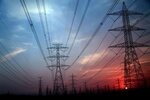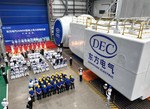News Release from American Clean Power Association (ACP)
Wind Industry Profile of
11/15/2011
AWEA - Wind power increasingly competitive and productive
Wind energy increasingly competitive and productive, new reports find. Wind power's costs are coming down and its usage is growing, according to two reports issued yesterday. The first, by London-based Bloomberg New Energy Finance (BNEF), said that land-based wind farm plants will be "fully competitive" with conventional electricity sources in five years; the second, from the U.S. Energy Information Administration (EIA), documented wind's increasing role in U.S. electricity generation, from some 6 billion kWh in 2000 to 95 billion kWh in 2010.
BNEF said it sees the cost of electricity from land-based wind turbines declining 12 percent by 2016 "thanks to a mix of lower]cost equipment and gains in output efficiency," adding, "The best wind farm plants in the world already produce power as economically as coal, gas and nuclear generators; the average wind farm will be fully competitive by 2016."
BNEF researchers estimated that manufacturing costs for land-based turbines drop by 7 percent for each doubling of installed capacity due to economies of scale and supply chain efficiencies. In 1984, the firm said, there were 300 MW of installed wind farm capacity in the world, and wind turbines prices averaged E2 million ($2.7 million) per MW; by the end of this year, there will be more than 240,000 MW installed, and prices in the first half of the year were below E880,000 ($1.2 million) per MW.
At the same time, according to BNEF, while turbine costs have been falling, "the power output achieved by each turbine as a percentage of nameplate capacity--the so]called capacity factor--has been rising steadily. This has been driven by the long]term move to bigger and taller turbines, better aerodynamics, better controls and gearboxes, as well as improved electrical generation efficiency. These improvements have increased capacity factors by 13 percentage points to 34% over the past 27 years." While each megawatt of capacity in the 1980s could be expected to generate 1.8 million kWh annually, today's turbines generate 2.9 million kWh per megawatt.
With operations and maintenance (O&M) costs also decreasing in real terms, BNEF said, the levelized cost of energy (not including subsidies) has fallen from E200/MWh (37 cents/kWh) in 1984 to E52/MWh (7 cents/kWh) today.
BNEF also sees reason for optimism on wind power's economics looking ahead: "Due to structural overcapacity and growing competition in the wind industry, we expect turbine prices to continue to fall over the next few years. At the same time, as designers roll out yet larger turbines with longer blades designed to capture more energy, even in low]wind locations, capacity factors will continue to increase. These two changes will drive the cost of wind energy down further, to parity with conventional energy sources. Assuming specific learning rates for these components, we expect wind to become fully competitive with energy produced from combined]cycle gas turbines by 2016 in most
regions offering fair wind conditions."
BNEF lead wind analyst Justin Wu commented, "The public perception of wind power tends to be that it is environmentally friendly, but expensive and intermittent. That is out of date in the best locations, where generation is already cost]competitive with fossil fuel electricity, and that will be the case for the majority of new onshore turbines installed worldwide by 2016.
“The press is reacting to the recent price drops in solar equipment as though they are the result of temporary oversupply or of a trade war. This masks what is really going on: a long]term, consistent drop in clean energy technology costs, resulting from decades of hard work by tens of thousands of researchers, engineers, technicians and people in operations and procurement. And it is not going to stop: In the next few years the mainstream world is going to wake up to wind cheaper than gas, and rooftop solar power cheaper than daytime electricity. Add in the same sort of deep long]term price drops for power storage, demand management, LED lighting and so on – and we are clearly talking about a whole new game."
The EIA report, a brief excerpt from the agency's annual energy review, looks at U.S. renewable energy consumption from 2000 through 2010 and is entitled "Use of U.S. wind and biofuels on the rise." A graph displays total renewable consumption and the market share for each energy source. It shows that total renewable energy consumption rose during the decade from about 6 quadrillion Btu's (quads) to about 8 (a quad is roughly equal to 100 billion kWh of electricity or half a million barrels of oil a day for one year). At the same time, the contribution from wind and biofuels jumped from near zero in 2000 to nearly 3 quads in 2010.
While noting that wind turbines generation increased by about 16 times (6 billion kWh to 95 billion kWh) over the period reported, EIA credits the rapid expansion to 1) the federal wind production tax credit (PTC); 2) state renewable energy standard (RES) laws, which require electric utilities to acquire a minimum percentage of the electricity they sell from renewable energy sources; and 3) establishment of Renewable Energy Credits (RECs), certificates that represent renewable energy production and can be traded to comply with RES laws.
For more information on this article or if you would like to know more about what www.windfair.net can offer, please do not hesitate to contact Trevor Sievert at ts@windfair.net
www.windfair.net is the largest international B2B Internet platform – ultimately designed for connecting wind energy enthusiasts and companies across the globe!
BNEF said it sees the cost of electricity from land-based wind turbines declining 12 percent by 2016 "thanks to a mix of lower]cost equipment and gains in output efficiency," adding, "The best wind farm plants in the world already produce power as economically as coal, gas and nuclear generators; the average wind farm will be fully competitive by 2016."
BNEF researchers estimated that manufacturing costs for land-based turbines drop by 7 percent for each doubling of installed capacity due to economies of scale and supply chain efficiencies. In 1984, the firm said, there were 300 MW of installed wind farm capacity in the world, and wind turbines prices averaged E2 million ($2.7 million) per MW; by the end of this year, there will be more than 240,000 MW installed, and prices in the first half of the year were below E880,000 ($1.2 million) per MW.
At the same time, according to BNEF, while turbine costs have been falling, "the power output achieved by each turbine as a percentage of nameplate capacity--the so]called capacity factor--has been rising steadily. This has been driven by the long]term move to bigger and taller turbines, better aerodynamics, better controls and gearboxes, as well as improved electrical generation efficiency. These improvements have increased capacity factors by 13 percentage points to 34% over the past 27 years." While each megawatt of capacity in the 1980s could be expected to generate 1.8 million kWh annually, today's turbines generate 2.9 million kWh per megawatt.
With operations and maintenance (O&M) costs also decreasing in real terms, BNEF said, the levelized cost of energy (not including subsidies) has fallen from E200/MWh (37 cents/kWh) in 1984 to E52/MWh (7 cents/kWh) today.
BNEF also sees reason for optimism on wind power's economics looking ahead: "Due to structural overcapacity and growing competition in the wind industry, we expect turbine prices to continue to fall over the next few years. At the same time, as designers roll out yet larger turbines with longer blades designed to capture more energy, even in low]wind locations, capacity factors will continue to increase. These two changes will drive the cost of wind energy down further, to parity with conventional energy sources. Assuming specific learning rates for these components, we expect wind to become fully competitive with energy produced from combined]cycle gas turbines by 2016 in most
regions offering fair wind conditions."
BNEF lead wind analyst Justin Wu commented, "The public perception of wind power tends to be that it is environmentally friendly, but expensive and intermittent. That is out of date in the best locations, where generation is already cost]competitive with fossil fuel electricity, and that will be the case for the majority of new onshore turbines installed worldwide by 2016.
“The press is reacting to the recent price drops in solar equipment as though they are the result of temporary oversupply or of a trade war. This masks what is really going on: a long]term, consistent drop in clean energy technology costs, resulting from decades of hard work by tens of thousands of researchers, engineers, technicians and people in operations and procurement. And it is not going to stop: In the next few years the mainstream world is going to wake up to wind cheaper than gas, and rooftop solar power cheaper than daytime electricity. Add in the same sort of deep long]term price drops for power storage, demand management, LED lighting and so on – and we are clearly talking about a whole new game."
The EIA report, a brief excerpt from the agency's annual energy review, looks at U.S. renewable energy consumption from 2000 through 2010 and is entitled "Use of U.S. wind and biofuels on the rise." A graph displays total renewable consumption and the market share for each energy source. It shows that total renewable energy consumption rose during the decade from about 6 quadrillion Btu's (quads) to about 8 (a quad is roughly equal to 100 billion kWh of electricity or half a million barrels of oil a day for one year). At the same time, the contribution from wind and biofuels jumped from near zero in 2000 to nearly 3 quads in 2010.
While noting that wind turbines generation increased by about 16 times (6 billion kWh to 95 billion kWh) over the period reported, EIA credits the rapid expansion to 1) the federal wind production tax credit (PTC); 2) state renewable energy standard (RES) laws, which require electric utilities to acquire a minimum percentage of the electricity they sell from renewable energy sources; and 3) establishment of Renewable Energy Credits (RECs), certificates that represent renewable energy production and can be traded to comply with RES laws.
For more information on this article or if you would like to know more about what www.windfair.net can offer, please do not hesitate to contact Trevor Sievert at ts@windfair.net
www.windfair.net is the largest international B2B Internet platform – ultimately designed for connecting wind energy enthusiasts and companies across the globe!
- Source:
- American Wind Energy Association
- Author:
- Posted by Trevor Sievert, Online Editorial Journalist / By Tom Gray, www.awea.org/blog/
- Email:
- windmail@awea.org
- Link:
- www.awea.org/...
- Keywords:
- awea, wind, wind energy, wind turbine, rotorblade, awea, ewea, wind power, suppliers, manufacturers, renewable energy, trevor sievert
All news from American Clean Power Association (ACP)
news in archive
Related News
China, Brazil Partnership
11/21/2024


























